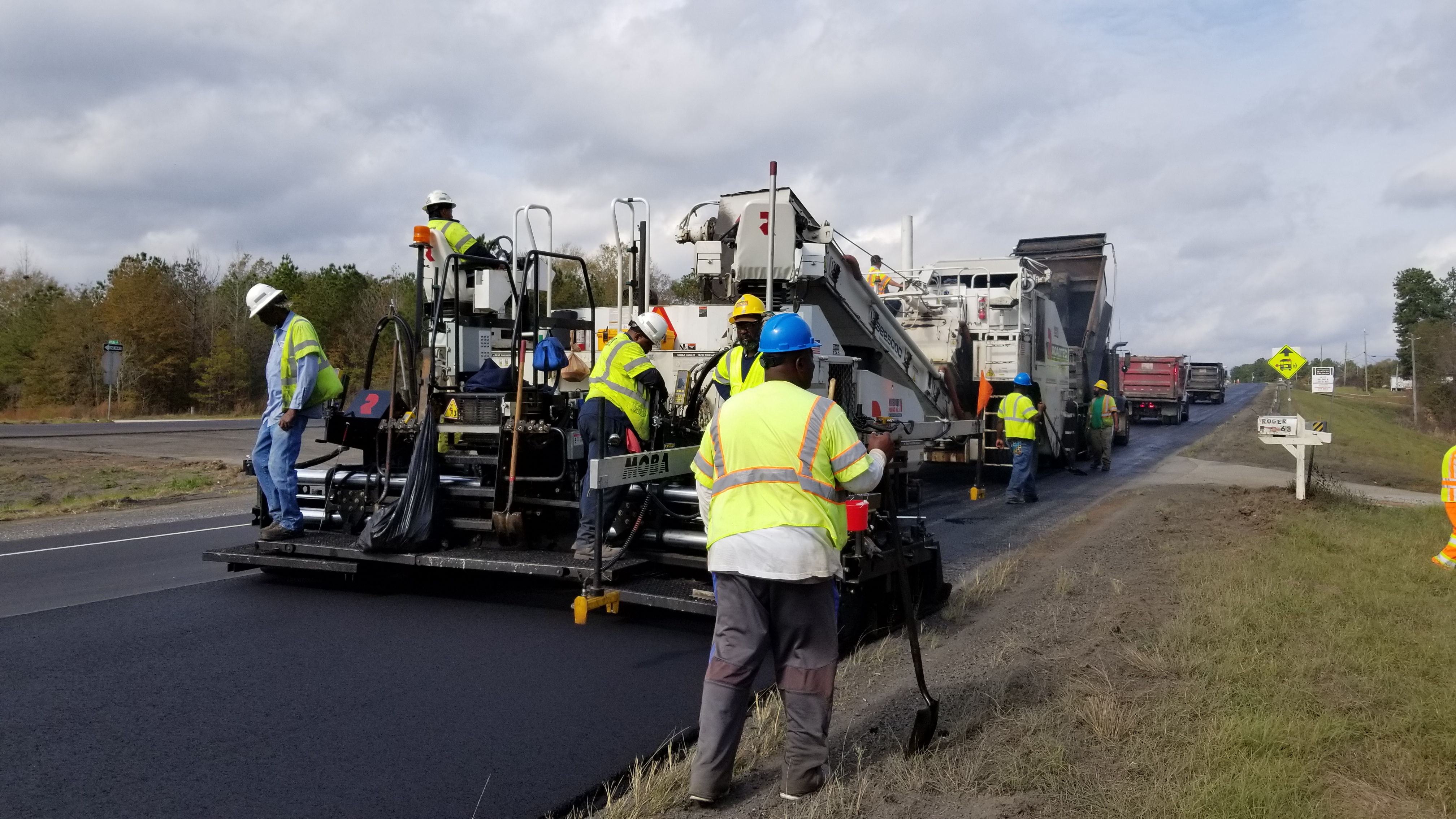- Spring 2021
Implementation Spotlight: Balanced Mix Design for Alabama Counties

A Midsouth Paving crew working in Eufaula, Alabama.
Purchase order mixes for Alabama counties are typically bid using the Alabama DOT’s (ALDOT) mix specifications but are not subject to the same rigorous construction quality testing as other projects. Counties often do not have an inspection presence at the contractor’s plant, and there is no formal mix quality documentation requirement.
Performance issues have been noted on some recent projects, and in the summer of 2019, engineers from Geneva and Houston counties in the southeast corner of the state reached out to NCAT for advice on the best way to improve their purchase order mix quality. A state motor fuel tax increase had been passed that gave Alabama counties greater flexibility for asphalt mix specification requirements. Initially, the counties asked about eliminating reclaimed asphalt pavement (RAP) to improve mix quality; however, NCAT suggested using a simplified balanced mix design (BMD) specification to ensure good rutting and cracking resistance and allow for higher RAP contents as long as the performance testing requirements could be satisfied during construction.
Research to validate laboratory performance testing was initiated at NCAT’s Test Track in 2015. The Cracking Group experiment was funded by numerous state DOTs and FHWA to assess which cracking tests have results that correlate well with field performance. Through this experiment, five tests provided favorable correlations to measured cracking performance on the track.
The simplicity of sample preparation and the ability to utilize existing equipment and generate results quickly made the IDEAL-CT test an attractive choice for use during construction of purchase order mixes procured by Alabama counties. Where the IDEAL-CT test utilizes the shape of an indirect tensile (IDT) load-deformation curve to detect potential mix brittleness at 77oF, the same testing equipment and samples can be used to screen a mix for poor rutting performance using the peak load at 122oF (i.e., hot-IDT testing). Mixtures can be screened for both cracking and rutting performance during construction within approximately four hours, which easily facilitates morning and evening testing. Based on proven performance on the track, the minimum CTIndex from the IDEAL-CT test was set at 50 and the hot-IDT minimum IDT strength was set at 17 psi for plant produced mixtures in the proposed specification for Alabama counties.
Local asphalt contractors responded to the specification change enthusiastically. When the bid was advertised, their first step was to evaluate their existing Superpave mixes to assess the need for mix design changes and opportunities to improve sustainability. They generally observed low CTIndex values and high hot-IDT values, noting that mixes utilizing lower RAP mixes exhibited higher CTIndex values. They iteratively adapted their Superpave mixes to meet the new cracking and rutting test requirements. The resulting blends resembled the Marshall mix designs that were used in Alabama until the time of Superpave implementation. These new BMD mixtures contained 35% RAP (compared to 20% RAP for the Superpave mix designs) and higher total binder contents of between 0.5% and 0.75% asphalt.
Contractors reported a longer time to obtain BMD results, with typically a full day to obtain a single data point. They also reported the need for more attention to detail with respect to times, temperatures and technologies. BMD results were found to be sensitive to conditioning time and a lack of precise temperature control that in one case necessitated an oven upgrade. A significant observation from the iterative mix design effort was the impact of RAP binder quality on mix performance results, noting that volumetrics can be blind to this effect. In the end, it was possible to increase to 35% RAP, but some RAP stockpiles that would have been used for Superpave mix designs did not work well in the BMD mix designs.
The new specification also resulted in significant testing changes during mix production. Contractors were required to determine both CTIndex and hot-IDT strengths. Using the contractor’s mix design as a starting point, production mix proportions necessary to satisfy performance results were established via a test strip. Mix performance testing was conducted within the first 100 tons of mix shipped each day, and testing was repeated if a mix was still being shipped after five hours and the total quantity shipped for the day exceeded 500 tons. Failing results necessitated retesting, while a second set of failing results demanded a new test strip to reestablish mix proportions and passing results.
Although acceptance was based on BMD results, contractors also needed to know total binder content, maximum theoretical specific gravity, gradation and air voids. This significant increase in production testing approximately doubled the time to generate lab results, making time and oven management more important in laboratory workflow management.
The importance of RAP quality was a significant factor in specification compliance with production mix. Higher CTIndex values (increasing by 8 to 25) and lower hot-IDT strengths (decreasing by 0 to 6 psi) were typically observed during construction compared to the mix designs. Paving crews reported that the new balanced mix designs were more workable in the field and generally took less compactive effort than Superpave mixes to achieve the required mat densities.
Table 1. Mix Design and Plant BMD Data for an 8,000-ton County Road Project in South Alabama.
|
9.5 mm |
Total Binder Content (Combination of Virgin and Recycled Materials), % |
CTIndex |
Hot-IDT, psi |
|
Laboratory Mix Design |
6.40 |
50 |
38 |
|
Average |
6.23 |
73 |
32 |
|
Standard Deviation |
0.13 |
18.3 |
13.6 |
The counties using this balanced mix design specification have been very pleased with cost, construction and early performance of mixes, even with much higher RAP contents. Although they had an option to continue to utilize Superpave mixes, they used the new specification for the vast majority of their purchase order paving work by the end of 2020. The bid price was 6% lower than comparable Superpave mixtures within the same work year, and it is expected that the overlays will have a longer service life based on observations during laydown and early performance assessments.
Contractors are enthusiastic because this specification provides for competitive innovation without traditional volumetric boundaries. The two counties plan to use it again for the 2021 paving season, and additional counties have plans for adoption. ALDOT is observing the county experience closely and plans to utilize their experience in the continued development of a balanced mix design specification for higher level traffic state projects as well as for county projects that require ALDOT oversight. In addition to monitoring the annual purchase order mix procured by Alabama counties, ALDOT’s long term plan for balanced mix design implementation includes shadow projects and trial projects at the state level.



For more information about this project, please contact Buzz Powell (left), Alex Murphree (center) or Justin Barfield (right).